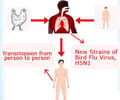A single-particle nanopore sensor with AI technology, created a new virus typing method that can be used to identify single influenza virions.

‘In addition to enabling early detection of influenza, this nanosensor method could be modified to enable early detection of other viral particles. ’





Genetic methods can identify many virus species, but require time-intensive processes and specialized staff. Therefore, these methods are unsuitable for point-of-care screening. In a novel approach, the researchers designed a sensor that could assess distinct nanoscale properties of influenza virions within physiological samples. "We used machine-learning analysis of the electrical signatures of the virions," says corresponding author Makusu Tsutsui. "Using this artificial intelligence approach to signal analysis, our method can recognize a slight current waveform difference, which cannot be discerned by human eyes. This enables high-precision identification of viruses."
In testing this sensor, the research team found that electroosmotic flow (liquid motion induced by an electric current across the nanopore) through the pore channel could block the passage of non-virus particles. This ensured that the only particles evaluated by the sensor were virus particles, regardless of the complexity of the sample that contained those viruses.
"Our testing revealed that this new sensor may be suitable for use in a viral test kit that is both quick and simple," says lead author Akihide Arima, "Importantly, use of this sensor does not require specialized human expertise, so it can readily be applied as a point-of-care screening approach by a wide variety of healthcare personnel."
This would enable rapid prevention and tracking for a variety of local epidemics and potential pandemics.
Advertisement









